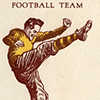As the 2016–2017 Bookbuilders of Boston scholarship recipient from Boston College, I was tasked with creating digital versions of previous Burns Library exhibits. When I began, I was excited, if not a little nervous, about learning new digital skills for presenting history. However, I quickly learned that the project would teach me how to bridge skills I previously developed as a graduate student in history with new ones, such as metadata creation and Omeka, to create accessible digital exhibits. We were able to do this for four exhibits: Are You Being Served, Around the World in 80 Books, Common Boston, and Recusant Books. While all four exhibits required slightly different approaches to representing them digitally, I used both analytical and creative thinking for each of them.
I used my analytical, historical perspective to help me think about how these exhibits should be organized for their digital versions. In some cases, it was easy to take what had been previously written and just copy/paste it to the digital exhibit. But, in most cases, many images and corresponding text were like puzzle pieces that I had to reassemble into a digital whole, rather than in the reality of an exhibit case. For example, the Are You Being Served exhibit had many eclectic pieces, and I was able to think about how best to tell this story for a broader audience. My first goal was to replicate what had already been created whenever possible, but, in the cases where it was difficult to tell, I had to think about what would best showcase the objects, while retaining the story of the exhibit. I found this required the kind of storytelling I’ve been taught to do as a historian, like considering whether to present the story thematically or chronologically, and what order the different sections of the exhibit should be in.
When creating the exhibit Around the World in 80 Books, because the focus on the original exhibit was about the beauty of the bindings, I wanted to make sure that emphasis came through digitally as well. Because I came to the project with more historical skills than digital, it took some trial-and-error to find the best way to present this content. I knew that being able to see the diversity and complexity of each book was important, so I settled on an exhibit style that showcased each book on one page, rather than making the user click through 80 pages. The uniformity of book shapes allowed this to have a clean and organized appearance—one that wouldn’t have necessarily worked with other exhibits. Similarly, the Recusant Books exhibit highlights the books on a single page, but because each book has more corresponding text, the style is somewhat different.
Finally, the Common Boston exhibit was probably the most fun for me because the period is in my wheelhouse—late 19th century America. The original exhibit had a beautiful range of objects that I wanted to ensure were represented well in its digital rendering. From police records, to books about the 1872 Boston Fire, to playbills from the era’s theatre productions, Common Boston was one of the most vibrant exhibits for me to work on.
Although digital projects can seem out of the comfort zone for those who stick to more traditional ways of presenting their research, the learning curve is not as steep as it might initially seem. In the end, I relied on many of the same skills I already possess as a historian. Finally, making exhibits digital creates the possibility to also make them more accessible—one of the most important things we as researchers do.
In 2018, the Bookbuilders of Boston scholarship recipient will continue this work to make more exhibits available online. Interested undergraduates and graduate students can apply for the scholarship by February 1, 2018. Additionally, the Digital Scholarship Group will be holding multiple workshops this semester on creating digital exhibits using Omeka.

Great, thanks for sharing this blog.Thanks Again. Will read on…
Thanks for helping everyone[ This site is really good9
sandyterrace.com
Zhu Houzhao는 “내 아들은 50% 확신한다”고 편리하게 말했다.